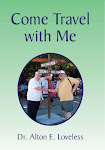
The Other Lexington
There are so many things to see in Lexington, Virginia. I will list only a few of them. First, you will find a Virginia military Academy, which was the first public, all military Academy in the country; a cemetery where Stonewall said he is buried; and beautiful Washington, and Lee University, where Robert E. Lee is buried in the campus chapel.
Being an avid Civil War student, always a background searches on a specially the famous general’s. Since, I had already been a number of years ago to Stratford Hall Plantation in Westmoreland County, Virginia, where Robert E. Lee was born; I sought for more information on him at the visitor’s center. He was the son of Major General Henry Lee III "Light Horse Harry" (1756–1818), Governor of Virginia, and his second wife, Anne Hill Carter (1773–1829). One of Lee's great great grandparents Henry Lee I was a prominent Virginian colonist of English descent. His mother grew up at Shirley Plantation, one of the most elegant homes in Virginia. Lee's father, a tobacco planter, suffered severe financial reverses from failed investments.
Little is known of Lee as a child; he rarely spoke of his boyhood as an adult. Nothing is known of his relationship with his father, who, after leaving his family, only mentioned Robert once in a letter. When given the opportunity to visit his father's Georgia grave, he remained there only briefly, yet while president of Washington College, defended his father in a biographical sketch while editing Light Horse Harry's memoirs. In 1809, Harry Lee was put in debtors prison; soon after his release the following year, Harry and Anne Lee and their five children moved to a small house on Cameron Street in Alexandria, Virginia, both because there were then good local schools there, as well as several members of her extended family. In 1811, the family, including the newly-born sixth child, Mildred, moved to a house on Oronoco Street, still close to the center of town and with the houses of a number of Lee relatives close by. In 1812, Harry Lee was badly injured in a political riot in Baltimore, and Secretary of State James Madison arranged for Harry Lee to travel to the West Indies. He would never return, dying when his son Robert was 11. Left to raise six children alone in straitened circumstances, Anne Lee and her family often paid extended visits to relatives and family friends. Robert Lee attended school at Eastern View, a school for young gentlemen, in Fauquier County, and then at the Alexandria Academy, free for local boys, where he showed an aptitude for mathematics. Although brought up to be a practicing Christian, he was not confirmed in the Episcopal Church until age 46.
While traveling through Lexington, we passed by here’s home and the Episcopal Church where Robert E. Lee was a devoted member.
Lee entered West Point in the summer of 1825. At the time, the focus of the curriculum was engineering; the head of the Army Corps of Engineers supervised the school and the superintendent was an engineering officer. Cadets were not permitted leave until they had finished two years of study, and were rarely permitted to leave the grounds of the Academy. Lee graduated second in his class and did not incur any demerits during his four-year course of study. Lee was commissioned a brevet second lieutenant in the Corps of Engineers.
One of the highlights four may wish to be able to visit the Chapel at Washington and Lee and to view the tomb were Robert E. Lee is buried just behind the pulpit area. In the basement of the Chapel is the Museum of many of the historical items of Lee’s. Also, there is a bookstore where one could buy books on the life of Lee and other related material. Just outside of the Chapel is the gravesite of “Traveler” Robert E. Lee’s horse.
Washington and Lee University is a great now school whose curriculum is well respected. The school is named after George Washington, who donated to keep you from ceasing to exist, and Robert E. Lee to after the Civil War came as its president.
As we continue to drive to the city we came to the cemetery where Thomas Jonathan "Stonewall" Jackson (January 21, 1824 – May 10, 1863) was buried with a large statue stone above his grave. He was a Confederate general during the American Civil War, and probably the most well-known Confederate commander after General Robert E. Lee. His military career includes the Valley Campaign of 1862 and his service as a corps commander in the Army of Northern Virginia under Robert E. Lee. Confederate pickets accidentally shot him at the Battle of Chancellorsville on May 2, 1863, which the general survived, albeit with the loss of an arm to amputation. However, he died of complications of pneumonia eight days later. His death was a severe setback for the Confederacy, affecting not only its military prospects, but also the morale of its army and of the general public.
The Virginia Military Academy, while it is an old-school, has many beautiful buildings and adds to the beauty of the city and is worth the visit.
Since there are sure many historical places in the city we decided to take a carriage ride, which lasted nearly 2 hours. We agreed to later that this was the way to go.
Afterwards, we went to a coffee nook for a delightful lunch before leaving.
Just north of the city are the birthplace of Sam Houston, of Texas fame, and the home of McCormick, the inventor of the McCormick reaper.
No one should visit this part of the Virginia without a stop in Lexington.
“And there was great joy in that city. “ -- Acts 8:8 (NKJV)





No comments:
Post a Comment